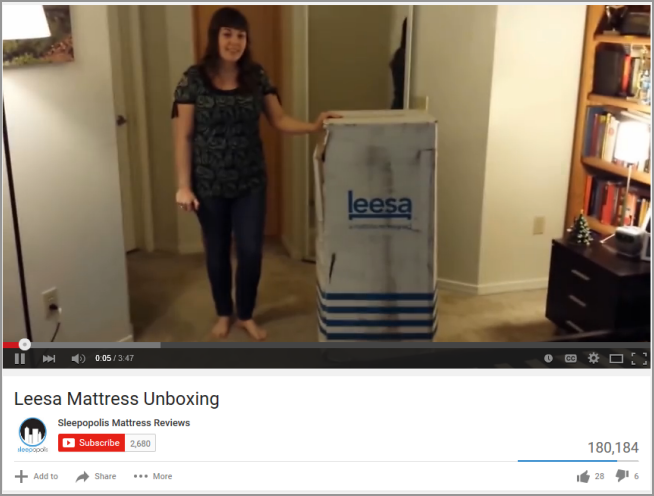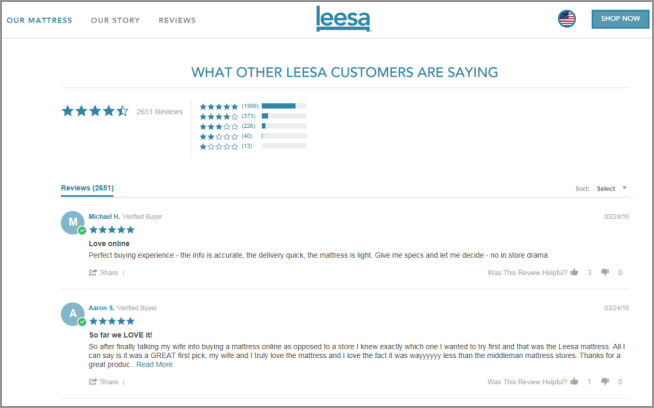
|
SUMMARY:
Leesa, a direct-to-consumer luxury mattress manufacturer, sells only online. There's no showroom to try out its mattresses. While customers can keep mattresses for 100 nights risk-free, the marketing team still has to build enough trust that prospects are willing to order it and invest their time and money sight unseen. |
by Andrea Johnson, Copywriter
"Generally, [our customers] are savvy online shoppers," said Matt Hayes, Head of Marketing and founding member, Leesa.
Leesa's product is a luxury version of a typical foam mattress, with the differentiator being that it ships compressed in a box directly to the customer's doorstep — a factor appeals mainly to millennials.
"Mostly millennials are looking for a better, easier way to purchase a luxury-quality mattress without the hassle of having to go to a traditional mattress showroom and dealing with all the pressure and marketing gimmicks that come along with that," he said.
The unique business model doesn't stop at how it sells and speaks to customers. Hayes said, Leesa also donates "one mattress to a shelter for every 10 mattresses that we sell."
Even with a 100-night risk-free guarantee, it requires a great deal of trust to spend hundreds of dollars on a mattress bought online, sight unseen.
Hayes believed unbiased reviews could be the most effective way to build that trust, so the company included them on the website.
However, Leesa also needed to distinguish itself even further in the marketplace. The team enlisted a vendor to help them identify which social media influencers had just the right audience that matched Leesa's target market. From there, the company offered key influencers an opportunity to try the product for free, in exchange for a review.
CAMPAIGN
The marketing team ramped up the campaign in the second quarter of 2014. Their goal was to reach:
The campaign evolved as Leesa grew in size, beginning with smaller bloggers who were strong converters. Once that phase produced positive results, the team began evaluating specifically what content was performing, and then amplifying that on a larger scale with more influencers on more platforms.
"The idea of having this very personal, authentic testimonial from someone that, me as a reader, I trust implicitly, that's really what we honed in on. Once we kind of nailed that, the content type, then we were getting more and more prescriptive about honing in on the metrics that mattered to us," he said.
The Leesa team started with bloggers who were identified as expert reviewers with ecommerce brands. They sent the reviewers a mattress in exchange for an unbiased review.
"We would send them a free Leesa mattress — there were tons of competitors that did the same thing. [The reviewer] would do an objective comparison of us versus competitors," Hayes said.
When people are in the market for a new mattress, he explained, "one of the first things you do is you go and search for reviews with the great SEO of these review sites … so we were getting a lot of that traffic."
The team then evaluated the results of the content produced by the initial group of bloggers to identify what type of content was most effective:
Because working with the initial group of reviewers had been so successful, Hayes wanted to be more aggressive about the strategy and widen the pool. The team began to work with a vendor to identify influencers who could have greater impact.
This group included bloggers influential in the interior design, DIY and style spaces to "broaden our reach and capitalize on the opportunity to have great, authentic native content with a segment of the market that we were largely untouched in, which has huge potential," Hayes said.
While working with the bloggers, the team identified and defined the following benchmarks to meet:
"When we do integrations, a lot of times it's for obviously a blog post but then they amplify it with posting to all their social channels as well. … So all of that is factored into evaluating the potential effectiveness of an influencer," he said.

Click here to see the full version of this creative sample
Hayes did not give bloggers any hard-and-fast rules about what they could say, but he did provide copy points and benefit statements.
"We want them to hit on the things we want them to say," he said. "But we didn't want to be overly prescriptive … because this is organic influencer content. If it's coming out of our mouth, it's no longer organic. It needs to come from the influencer's mouth."
This required trust on Leesa's part.
"We need to trust our product is good enough that they're going to be super excited about it," Hayes said. "And 98% of the time, that's always the case."
Every blogger who received a mattress for a review was also given a unique promo code or vanity URL to offer to their readers. Hayes wanted to make sure the call-to-action made the audience feel as if it was speaking directly to them and they were getting an urgent, exclusive offer.
"Doing all the things that we know from a direct-response perspective is known to drive conversions, that's where we really started to hone in and see some great performance," he said.
YouTube is a pivotal platform for Leesa, because it shows the product off from two vantage points:
One of the most exciting pieces of content was an "unboxing video" where reviewers would record themselves opening up the Leesa box, and viewers could watch the mattress unfurl in real time.
In sponsoring a channel, the unboxing or review videos would feature in the description of videos a statement such as "For an exclusive $75 off, go to www.leesa.com."

Click here to see the full version of this creative sample
"We've run integrations like that with videos that hit over a million views on a single video, so they can be quite big," Hayes said.
One of the sponsorships was on YouTube channel TLDToday with Jonathan Morrison, the title of which was "Best Home Tech of 2015." That one video has over a half a million views to date, and when searching keyword terms such as "home technology 2015," that video comes up first.
Leesa encourages customer reviews by sending only two emails — a deliberately limited outreach, according to Hayes.
"We don't inundate them with a drip series," he said. "We certainly don't hound our customers for reviews."
He added that many customers consider other customers' opinions every bit as valuable as social media influencers. It's important to integrate both voices to establish trust.
"A lot of people, especially our audience, are hip to the game and they're savvy about how a lot of these content creators are compensated," he said. "There can always be a bit of distrust. You can't argue with the reviews on Amazon and the on-site customer reviews. These are verified buyers saying specifically that they love our mattress."

Click here to see the full version of this creative sample
Reviews that come in from customers are integrated on-site, which is a feature Leesa has had "really since day one," Hayes said, when the company beta launched.
"Ever since then, we've been gathering on-site reviews where we email the customer 45 days after the purchase, because we want to give them a sufficient amount of time to have slept on the mattress and formed their own opinion," he said.
"The influencer market is the wave of the future," Hayes said. "It's the way people are absorbing content now, the way they want to be delivered ads. … That's the way millennials are shopping and buying now. Everything is content-based. You have to go where people are."
The program has driven 100,000 clicks to the Leesa website and has directly resulted in more than 400 mattress sales.
Hayes advised that any marketers who want to run an influencer campaign at scale — particularly when managing the effort in-house — to have a method for estimating conversion and tracking back to measuring performance.
In doing this, he said, "You can get better about the creative that you're choosing, about the messaging that you choose and the content creators."
Leesa
Mediakix — Leesa's vendor
Social Media Marketing: How Lilly Pulitzer, Kahlua and Neiman Marcus use brand influencers
Social Media Marketing: Visual storytelling drives 4.4 million Instagram engagements for Lilly Pulitzer [MarketingSherpa case study]
Social Media Marketing: An inside look at Neiman Marcus' Pinterest and blogger relations strategies [MarketingSherpa case study]
Social Media Integration: Holiday campaign increases Kahlúa's Pinterest followers 1,432% [MarketingSherpa case study]
Get Better Business Results With a Skillfully Applied Customer-first Marketing Strategy

The customer-first approach of MarketingSherpa’s agency services can help you build the most effective strategy to serve customers and improve results, and then implement it across every customer touchpoint.
Get More Info >MECLABS AI

Get headlines, value prop, competitive analysis, and more.
Use the AI for FREE (for now) >Marketer Vs Machine

Marketer Vs Machine: We need to train the marketer to train the machine.
Watch Now >Live, Interactive Event

Join Flint McGlaughlin for Design Your Offer on May 22nd at 1 pm ET. You’ll learn proven strategies that drive real business results.
Get Your Scholarship >Free Marketing Course

Become a Marketer-Philosopher: Create and optimize high-converting webpages (with this free online marketing course)
See Course >Project and Ideas Pitch Template

A free template to help you win approval for your proposed projects and campaigns
Get the Template >Six Quick CTA checklists

These CTA checklists are specifically designed for your team — something practical to hold up against your CTAs to help the time-pressed marketer quickly consider the customer psychology of your “asks” and how you can improve them.
Get the Checklists >Infographic: How to Create a Model of Your Customer’s Mind

You need a repeatable methodology focused on building your organization’s customer wisdom throughout your campaigns and websites. This infographic can get you started.
Get the Infographic >Infographic: 21 Psychological Elements that Power Effective Web Design

To build an effective page from scratch, you need to begin with the psychology of your customer. This infographic can get you started.
Get the Infographic >Receive the latest case studies and data on email, lead gen, and social media along with MarketingSherpa updates and promotions.